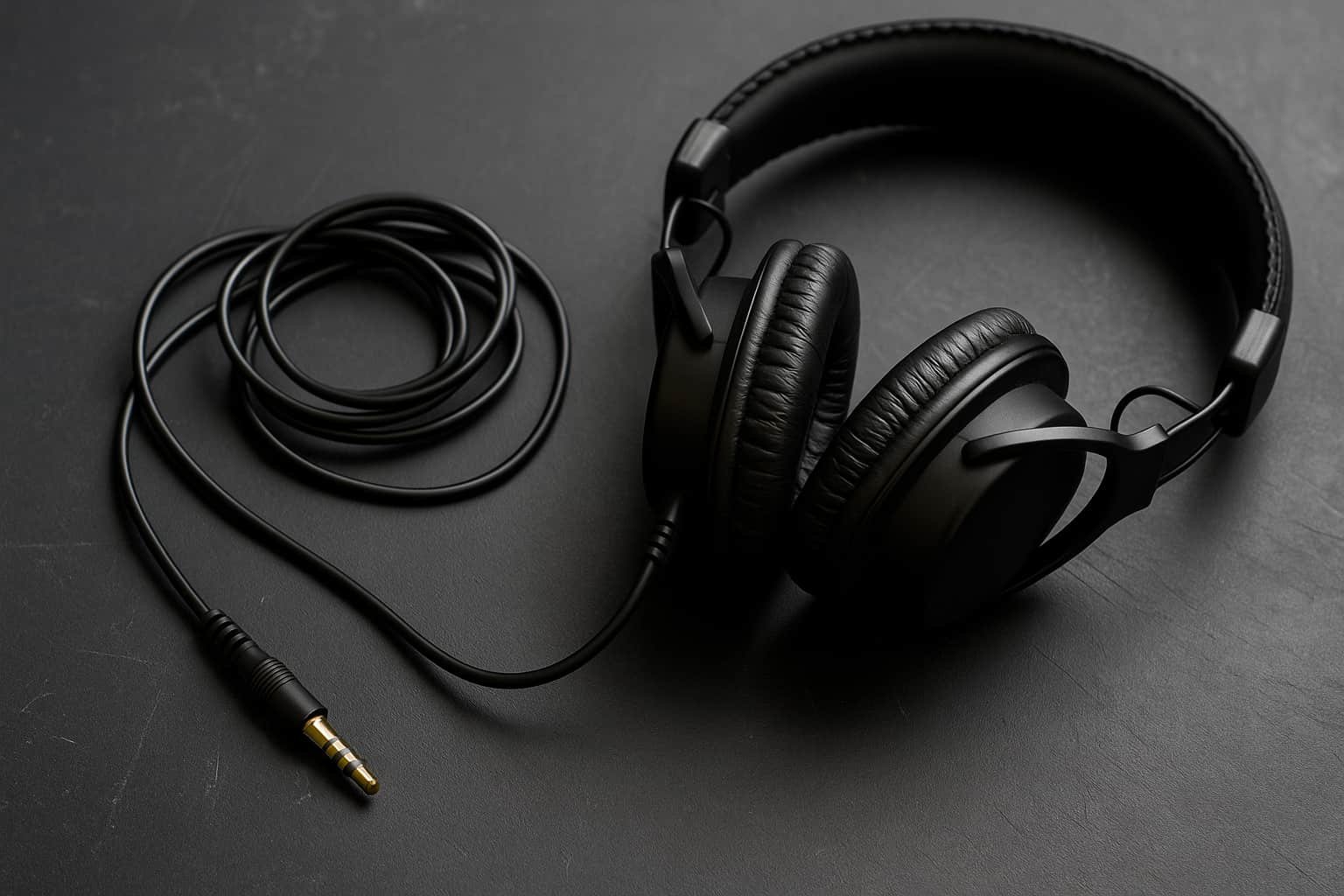A headset should make things easier. Whether you’re on a call, in a meeting, or just enjoying some music, it’s supposed to fade into the background and let you focus on what matters. That’s why static noise can be so frustrating — it disrupts everything. You hear a buzz or hiss in one ear, the person on the other end starts sounding like they’re calling from inside a snowstorm, and suddenly you’re fiddling with cables instead of concentrating on the conversation.
Table of Contents
If you’ve ever asked yourself why your headset is making static noise, the answer isn’t always obvious — but it’s usually solvable. The cause might be as simple as a loose connection, or it might be a deeper issue like software conflict or interference. Let’s go through the most likely sources of static in both wired and wireless headsets, and how to deal with each of them.
Where Is the Static Coming From?
Before you start fixing anything, it’s important to isolate the problem. Static can come from the headset itself, the device it’s connected to, or even the environment around you.

If you skip this step, you might end up replacing a perfectly good headset — or worse, keep using a broken one, thinking it’s your computer’s fault.
Start by asking yourself a few things:
Is the static always there, or only during calls?
Does it happen on more than one device?
Is it louder when the mic is active?
Each of these questions helps narrow down the source of the problem. Once you’ve done that, you can start troubleshooting.
Static Noise in Wired Headsets: What Causes It?
With wired headsets, the most common causes of static are physical. The cable might be damaged. The jack might not be seated properly. Dust or lint inside the port could be interfering with the signal. Even bending the cable a certain way might trigger the noise — which usually means internal wiring is frayed.

Sometimes the issue is as simple as a mismatch between ports. For example, plugging a 3-ring TRRS jack into a TRS port can cause interference, especially if the headset has both mic and audio lines. Other times, the source is entirely electrical — power supply interference or a noisy motherboard audio output, especially on older desktops and laptops.
You should also consider driver issues. In rare cases, outdated or corrupted audio drivers can introduce distortion, especially when headsets are connected via USB.
What About Wireless Static?
If you’re using a Bluetooth or wireless USB headset, the static often comes from signal interference or distance issues. Think of how many devices around you are emitting wireless signals — phones, routers, monitors, even your fridge. All of these can affect Bluetooth stability.

Low battery can also be a culprit. As power drops, the signal might weaken or become unstable. Some users also report a faint buzzing when charging wireless headsets while using them — often caused by poor grounding or USB interference.
Then there’s range. Most wireless headsets have an effective range of 10–30 meters, but walls, metal objects, and other wireless devices can cut that down dramatically. Even being too close — such as placing the headset’s receiver right next to your laptop’s Wi-Fi chip — can cause static or clicking.
Troubleshooting Static in Wired Headsets
Fixing static in wired headsets usually starts with process of elimination. Unplug the headset, wait a few seconds, and plug it back in. Wiggle the cable gently near the connector. If the static comes and goes, there’s a good chance your cable is damaged internally.
If you’re using a 3.5mm jack, clean it with compressed air or a dry brush. Dust buildup is a common and overlooked cause of poor contact. If compressed air isn’t available, blowing gently into the port can temporarily help — though it’s not ideal long-term.
Another quick test: plug your headset into another device. If the static disappears, the issue is likely with your original device — possibly the port itself or the audio settings.
On the other hand, if your headset uses USB, try a different port. Some ports — especially on older desktops — may produce interference if they share power with other high-drain devices.
And if none of this works? Try someone else’s headset on your computer. If theirs works fine and yours still crackles, it may be time for a replacement.
“Static that reacts to touch or movement is almost always physical — either the cable, the plug, or the port.”
Troubleshooting Static in Wireless Headsets
When it comes to wireless headsets, the problem is usually invisible — and that’s what makes it harder to solve. There are no frayed wires or dusty ports to check. Instead, you’re dealing with signal strength, Bluetooth protocols, and interference you can’t see.
Start with the basics: are you too far from your computer or console? Even premium headsets have distance limitations. Moving more than 10 meters away, or having walls or metal objects in between, can introduce signal instability. On the flip side, being too close to the transmitter — say, within 10cm — can sometimes overload the signal and cause distortion.
If your headset supports both Bluetooth and a USB wireless dongle, try switching modes. Some Bluetooth implementations are more prone to latency or static, especially when paired with older devices.
It’s also worth checking for nearby interference. Microwaves, routers, even fluorescent lights can cause short bursts of interference, especially in crowded workspaces. Try stepping into a different room or turning off other wireless devices nearby.
And don’t forget the software side. Wireless headsets often rely on drivers that need to be kept up to date. If you’re getting random static bursts or popping sounds, visit the manufacturer’s website and see if there’s a firmware or driver update available.
“Most wireless headset issues come down to one of three things: range, interference, or software.”
Is It the Mic or the Speakers?
A common misconception is that all static comes from the audio output. In fact, many headsets — especially those used for calls — pick up static from the microphone instead. If people tell you you sound muffled, robotic, or too loud, the mic might be too close to your mouth or positioned incorrectly.
A good rule of thumb: keep the mic about two fingers’ width away from your face, just below your lower lip. Too close, and you’ll get breath noises and distortion. Too far, and it picks up room noise instead of your voice.
Some users also experience static only when the mic is active — especially on cheaper models. Lowering the microphone sensitivity in your system settings, or disabling voice activation features, can help reduce this.
When Troubleshooting Doesn’t Help
Let’s be honest — not every headset is worth saving. If you’ve cleaned the jack, updated the drivers, adjusted the mic, and the static in your headset still won’t go away, the issue might simply be hardware failure.
Headphones, especially budget models, aren’t built to last forever. Connectors wear out. Internal cables snap from daily use. Even exposure to humidity can cause interference in the audio signal.
If you’re using a headset for professional work, gaming, or frequent calls, it may be time to consider a replacement. Higher-end models are not just more durable — they’re also better at suppressing static, isolating your voice, and avoiding interference altogether.
Recommended Wired Headset Upgrades (Without the Static)
Some static issues can only be solved by switching to better hardware. Here are two top-tier wired options that balance durability, clarity, and comfort:
EPOS Impact 800 ANC Corded Headset
One of the rare wired headsets with built-in Active Noise Cancelling. Designed for professionals, this model supports both USB-A and USB-C, making it compatible with most modern devices without extra adapters. The sound is crystal-clear, and the microphone filters out ambient noise with surgical precision.
“If your job depends on being heard clearly, this is the headset that won’t let you down.”
Jabra Evolve2 40
Renowned for its plush memory foam earpads and comfortable fit, the Evolve2 40 is built for long work sessions. It’s fully optimized for Teams and Zoom, and its wideband audio performance means voices sound natural, not tinny. Plus, it comes with a two-year warranty — just in case.
Recommended Wireless Headset Upgrades
If you prefer a wireless solution but want to avoid static for good, these two options are among the best:
EPOS Impact 1000 ANC Bluetooth Headset
This isn’t just another Bluetooth headset. With a best-in-class noise-cancelling mic and a range of up to 30 meters, it’s designed for office environments and busy homes alike. ANC in the earcups lets you focus even in noisy surroundings.
“In 20+ years of testing, we’ve never seen a cleaner microphone signal.”
Jabra Evolve2 65
These are a step up in every way: better battery, sharper sound, more reliable Bluetooth pairing. You get stereo-quality audio for music and rich vocal clarity for calls — plus compatibility with both mobile and PC.
Final Thoughts
Sometimes, the solution to static isn’t in a setting or a driver — it’s in the hardware itself. If your headset is buzzing, crackling, or cutting in and out, that’s a sign your gear is no longer reliable.
You can try to fix it — and hopefully this guide helped you do just that. But if not, upgrading to a quality headset can eliminate static altogether. It’s not just about sound quality — it’s about peace of mind. When your voice matters, you can’t afford to sound broken.
“The best fix for static is often prevention — and that starts with a headset that’s built right.”